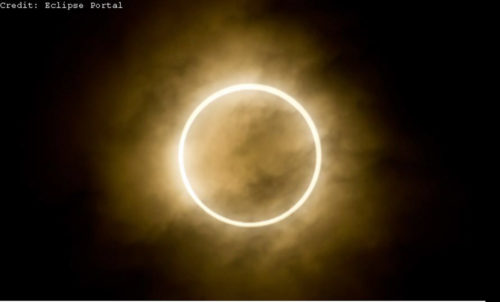
On Thursday, 26th December 2019, nature will have its way to greet us with a spectacular celestial event which can be experienced by people living across Southern India. This dramatic interaction of Sun & the Moon, the Annular Solar Eclipse can also be experienced from Saudi Arabia & its neighbouring countries to Indonesia & Malaysia.
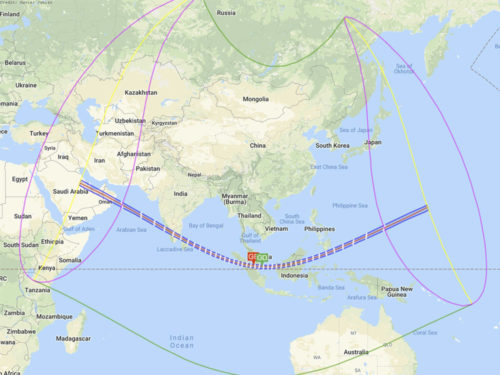
The path shown on a World Map is where Annular Solar Eclipse will be seen. The surrounding region will experience only a partial Solar Eclipse.
Solar Eclipse is the astronomical event that the Sun is hidden partially or totally by the Moon when it crosses in front of the Sun. When the Sun is totally hidden, it is called Total Solar Eclipse.
Annular Solar Eclipse is when the apparent size of the Sun is larger than the Moon, and the Sun can be seen surrounding the Moon. When the Sun is hidden by the Moon partially, the phenomenon is called Partial Solar Eclipse.
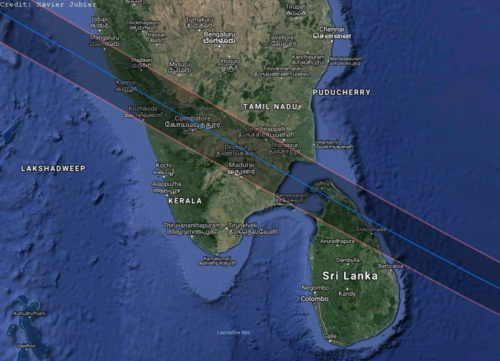
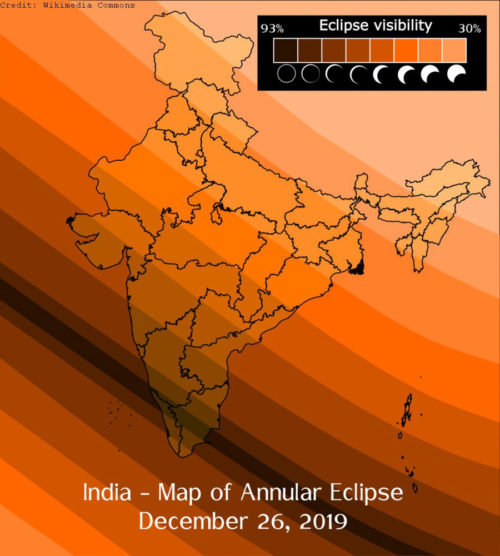
This image shows the visibility of the Annular eclipse in India (The densest shade) Rest will get partial Solar Eclipse.The event will last 3 minutes and 40 seconds at the point where the maximum annularity of the eclipse can be seen.
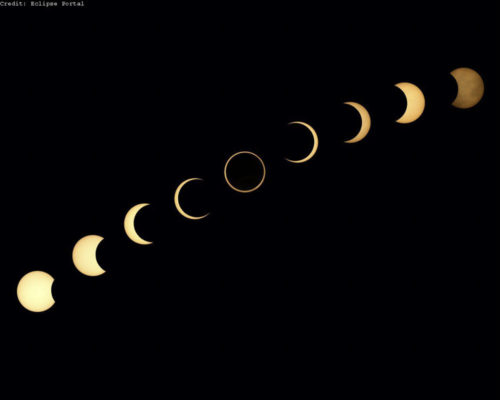
During this event, the Sun will be apparently 1.7% larger than average & the apparent size of the Moon will be 1% smaller due to its period on the orbital path around the earth. This size of the moon is not large enough to cover the Sun. Hence, it is an Annular Solar Eclipse. A Ring of Fire.
The interplay between the Sun & Moon will begin a few minutes after 8 AM IST & will last till 11.30 AM IST. The Annularity will be at its Maximum for 3 minutes which begins & end at the time-space of 9:27 IST & 9:30 IST
The important cities which can experience the whole annularity falling on the path will be Kozhikode in Kerala, Mangalore in Karnataka and Tiruppur, Coimbatore & Trichy in Tamil Nadu and some other regional cities.
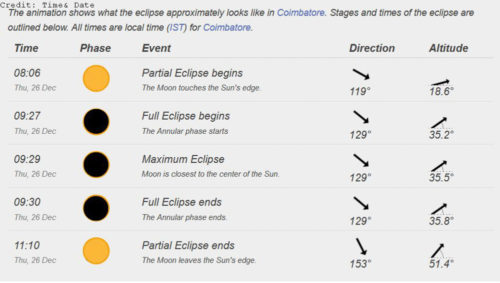
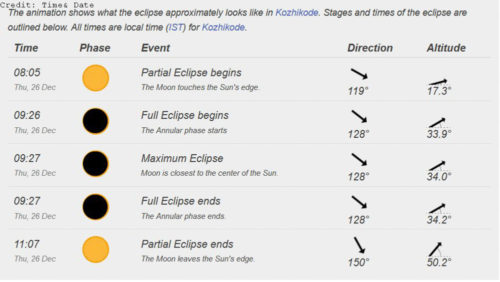
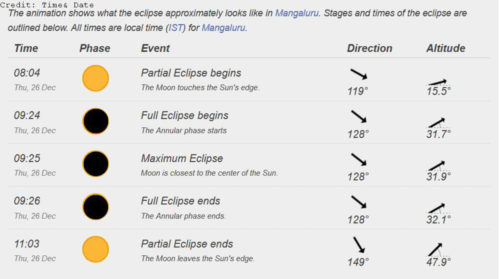
Speaking about safety, An Annular Eclipse of the Sun is not safe to look at with the naked eyes at any time, therefore use proper solar viewing protection at all stages of the eclipse.
Even when 99% of the Sun’s surface is covered during the partial phases of a total eclipse, or during an annular eclipse, the remaining sliver of the Sun is intensely bright — just as intense as at any other time — and cannot be viewed safely without proper eye protection. Failure to use appropriate filtration can bring up defects in your eye. An indirect viewing can be good, such as projecting the whole scenario on a big screen. Although you should have a Solar filter in hand, gaze through it.
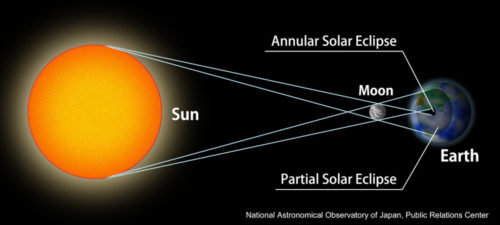
When the moon passes directly between Earth and the sun, those on Earth are treated to one of nature’s greatest spectacles—a solar eclipse. It is a phenomenon that almost every observer would like to capture in a photograph. Due to the rarity of the event, the short duration in which to capture it, and the dynamic nature of the subject, it is one of those photographic opportunities that require the proper gear, setup, planning, and practice.
Plan your eclipse photography, have the right gear, and practice, practice, practice on the non-eclipsed sun before the big event.
- DO NOT look at the sun with your naked eyes. Permanent damage to your eyesight and even blindness may result. ALWAYS wear certified solar viewing glasses when viewing the sun before, during, and after an eclipse. During an eclipse, when the moon covers a portion of the sun, the intensity of the light remains constant. The ONLY time it is safe to look toward the sun with the naked eye is during the brief period of totality at the height of a total eclipse of the sun. This eclipse has no totality, so do not look at with the naked eyes at any time.
- DO NOT point a camera at the sun unless the optics are fitted with a certified solar filter. Optics can magnify the intensity and brightness of sunlight, and this can cause damage to your equipment.
- DO NOT look through the viewfinder of an unfiltered DSLR camera when it is pointed at or near the sun because of the increase in intensity and brightness of the sunlight passing through magnifying optics.
- DO NOT look through the viewfinder of a rangefinder camera when it is pointed at or near the sun, as the optical viewfinder will not protect your eyes from the sun’s damaging light.
- DO NOT point an unfiltered digital camera at the sun and use live view or an electronic viewfinder, due to the possibility of focusing concentrated, unfiltered sunlight at your camera’s sensor.
A solar eclipse is not an everyday event. Some people will go their entire lives without witnessing one. Some will travel far and wide to try to see one or more in a lifetime—especially for rare total solar eclipses.
So, what you DO NOT want to do is spend an entire eclipse event messing around with your camera gear, or viewing it entirely through a camera’s viewfinder or on an LCD screen.
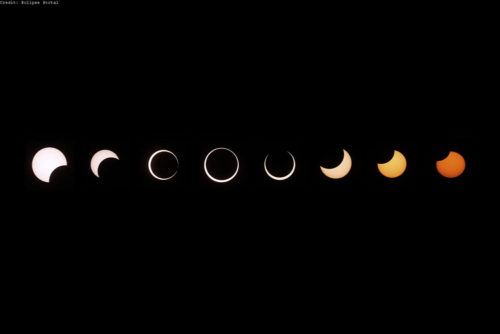
LOOK at the eclipse with your own (protected) eyes. As amazing as it would be to get a great photograph, I promise you that you will have a lifetime of regrets if you miss the whole show because you are hyper-focused on photographing the event. Besides, I’ve been told it looks much more amazing to the eyes than it does to the camera.
Basic Gear
- Eclipse glasses. You’ll need these for a couple of reasons. You’ll want to view the eclipse with your own eyes and, you’ll need them to better aim your camera at the sun.
- You do not need a professional DSLR camera to photograph the eclipse. In fact, any camera will do, depending on how you want to capture the event. You just need to take the proper precautions to protect the camera (and your eyes).
- The sun is beyond bright, so, when photographing the partial phases of an eclipse, you don’t technically need camera support to avoid camera shake, because your shutter speeds will be very short. However, during totality, the sun is blocked out, which basically means that you are photographing in darkness. Since this is an annular eclipse, you won’t have these issues.
- Remeber if you are holding heavy gear for over 3 hours you need support. I strongly suggest a sturdy camera tripod.
- Remote shutter release. When it gets dark, your shutter speeds will fall and you’ll want to trigger your camera remotely with a cable release, electronic release, or mobile device to prevent camera shake and blurring of your images.
- Not to forget, when photographing the sun, you will compulsorily need a solar filter for your camera and lens. The ONLY time the filter is not needed is during the totality portion of a total solar eclipse which will not occur during annular eclipse like this one.
Several online tutorials mention using a neutral density filter or stacking neutral density (ND) filters. I ONLY recommend using a properly designated solar filter. I am not alone in this recommendation. Experts at NASA, the National Science Foundation, the American Astronomical Society, Nikon, Space.com, Sky & Telescope magazine, and others all recommend solar filters instead of neutral density filters. Why? Because these are the only filters designed specifically for viewing the sun, and they are constructed to not only sufficiently dim the sunlight, but they also protect your eyes and equipment from non-visible IR and UV radiation. Solar photography is NOT the time to experiment with homemade filtration concoctions, like Stacking polarizers and ND filters, in an effort to save a few bucks.
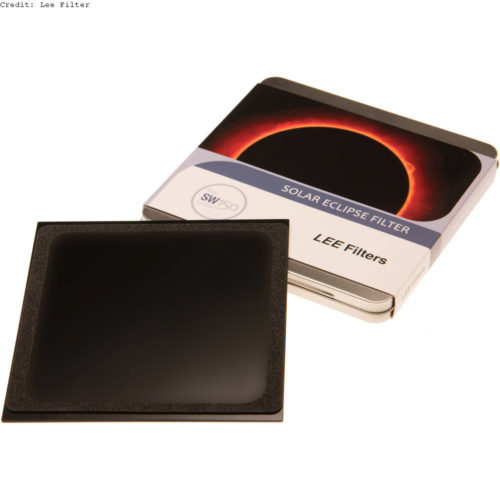
There are some ND filters out there marketed for solar photography. If you are looking for this type of filter, it looks like the consensus among brands is that 16-stops is the minimum strength for a filter. Lee filters has 20 stop 6.0 ND Solar Eclipse Filter. Use at your own risk!
WARNING: Do NOT use these ND filters with an optical viewfinder! Many come with fine-print on their packaging, so use due diligence and stick to using your Live View mode or an electronic viewfinder. Your safest option is a solar filter, but the optical glass ND filter may have other uses besides solar photography.
When it comes to solar filters, you have several options: filter sheet, screw-on front filter, or a solar filter that mounts between the camera and lens on an interchangeable-lens setup.
Filter sheet Mylar white-light solar filters come in different shapes and sizes. Many veteran observers also use sheets of #14 Welder’s Glass, which they mount or hold in front of the camera.
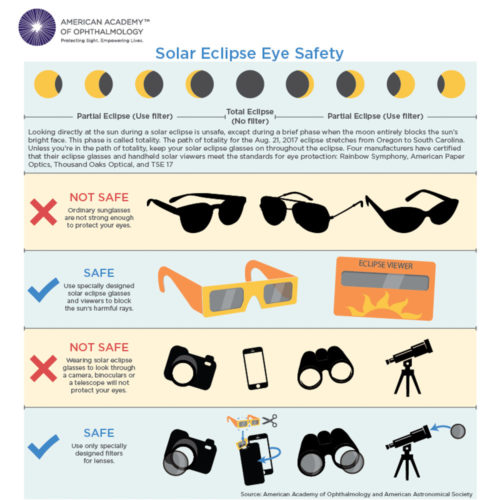
Screw-On Filter These white-light filters thread on your camera lens just like a standard threaded filter. However, they are designed for solar observing. Some are made of Mylar film inside of a filter ring, and others are made from optical glass. Pay attention to the fine print, some filter brands state that you should not look through an optical viewfinder or eyepiece while using them—they are for electronic viewfinders or LCD screens only.
If a screw-on filter does not have the correct diameter for your chosen lens, you can simply employ a step-up ring and adapt the larger filter to your smaller lens.
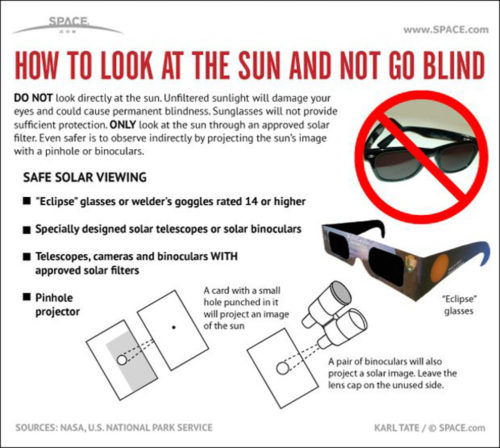
The colour of the sun in your images is dependent on the type of white-light solar filter used. Metal-coated glass and black polymer filters result in a yellow or orange tint. Aluminized Mylar filters show a bluish sun. #14 Welder’s Glass creates a greenish image. You can use white balance adjustment and can get better colour rendition later in post-processing.
WARNING: Regardless of the filter system you employ, take care to ensure the filter does not accidentally come off your rig while photographing the sun. I suggest using gaffer tape to secure the filter to the lens.
Lenses and Focal Length
When we think of the midday sun overhead, we envision it filling the sky with brilliant light. The truth is that even though the sun is 864,000 miles wide (109 times the size of Earth), the fact that it is approximately 93 million miles away means that it appears to be almost the same size as the Moon in our skies. Don’t believe me? Just look at a solar eclipse to see how the moon, when it is at or near its closest approach to Earth (perigee), blocks out the entire sun. During this Dec 26 eclipse, the moon is farther from Earth (apogee), the result is a partial blockage of the sun during what is called an annular solar eclipse.
What this means is that, with a wide-angle lens, the sun is very small in your frame. With a standard-length telephoto lens, the sun is slightly larger, but not frame-filling. To fill your viewfinder, you will likely need to go well past a 300mm focal length lens. I am planning to use the 100-400mm lens.
Do some research online by looking at the thousands of images of solar eclipses available on photo sites. Many have information on the gear used to capture a particular image, including camera type, lens focal length, and exposure settings.
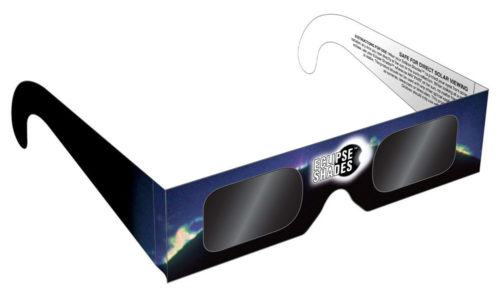
Camera Settings
During the progression from direct sunlight to the height of a total solar eclipse, the light will quickly change from broad daylight to twilight-like darkness. For the photographer, this is a blessing and a curse. The light really will not change dramatically until the eclipse approaches totality, so your camera settings can be static for a huge portion of the event—a good thing. The curse is that when the eclipse show is at its most exciting, the light will be changing quickly, and you must be ready to adapt. Bummer!
Luckily for all of us, eclipse photographers have given us some great exposure guidelines on which to base our settings, so we can efficiently prepare for the show.
During the total eclipse, when it reaches totality and you have removed your solar filter from your camera, this is the time to start bracketing your shots heavily. Use the exposure guide as just that, a guide. Bracket, bracket, and bracket some more. Since this time the eclipse never reaches totality, you don’t get this opportunity.
When it comes to ISO, you should set your camera to its native ISO—the lowest un-boosted ISO setting. For most cameras, this is ISO 100.
- DO NOT USE A FLASH. When the sun is out, the flash is useless. When the sun is obscured and all is dark, your flash will not illuminate the dark side of the moon, but it will annoy those around you trying to enjoy the spectacle. Also, by popping a flash, you will prove to everyone present that you don’t read this blog and, therefore, have no idea what you are doing with your camera.
- Stock up on memory cards and shoot raw files. Have sufficient memory to handle a lot of raw images.
- Use mirror lock-up on a DSLR camera to minimize vibration.
- Don’t be afraid to underexpose by a stop or two, or more. Avoid blown-out highlights. Use the highlight clipping warning (blinkies).
- Take an occasional glance at your histogram to verify exposure.
- Use live view or an electronic viewfinder for the what you see is what you get It is also safer for your eyes to NOT be looking through an optical finder if you ignored my advice about securely mounting a filter.
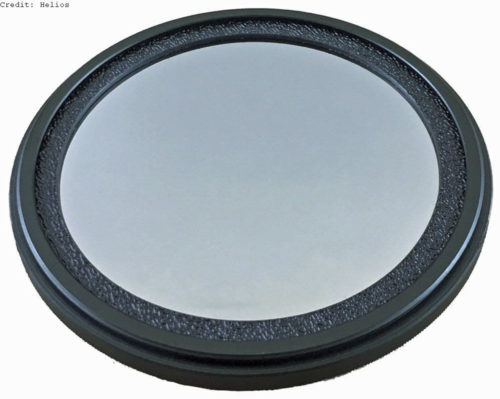
Composition Tips
If you are photographing the sun (and the eclipsing new moon) as the only subject in your image, you can certainly centre the sun in the frame. But, feel free to position your subject using the rule of thirds, or place it somewhere else in the frame for potentially dramatic effects or a unique look.
If you are shooting a wide-angle image and want to include some foreground detail, be sure that whatever you include in the foreground will not block the path of the sun, and be careful not to let that scenery dominate the scene—the dramatic display of this rare event will focus all attention on the solar eclipse. Also, with a solar filter in place, the foreground scenery will not show up in a photograph, so you will likely need to make multiple exposures.
For a telephoto lens, you can just wait for totality, point your camera at the sun and moon, and snap a photo, but you will likely want to capture all the wonderful phases of the solar eclipse. This means you will need to track the sun across the sky for a few hours, and keep shooting as the eclipse moves toward totality and then back toward a full sun on the other side.
This is where planning comes in. How many photos do you want to take? Should you divide the eclipse up into equal parts by time and capture, for instance, one image every six minutes before and after totality? Many photographers put together beautiful montages showing the progression of the eclipse through its entire cycle. If you are planning on a montage or image series, you will want a solid game plan going into the event. For those planning multiple exposures, know that the Earth’s rotation causes the sun to move the distance of one solar diameter through the sky approximately every two minutes.
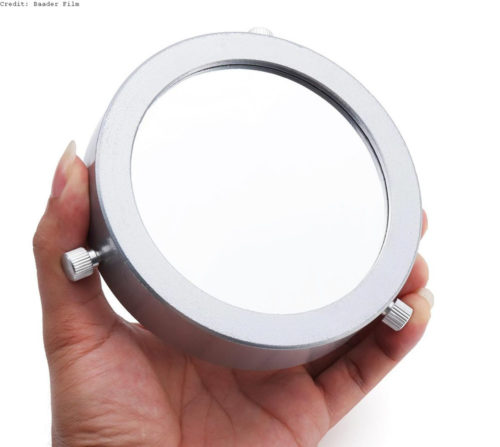
Also, you have to track the sun across the sky—either manually by hand or on a tripod, or with an electronic tracking telescope mount. One advantage of the mount is that, if used correctly, the sun will remain at a constant position through your frames and you will not have to work to manually track the event.
The benefit of using a normal focal length lens or a non-super telephoto is the ability to include some surrounding scenery in the foreground of your eclipse image(s). This is especially cool if you are shooting the sun before a spectacular mountain range, rock formation, man-made landmark, something else visually complimentary, or something that provides a sense of location.
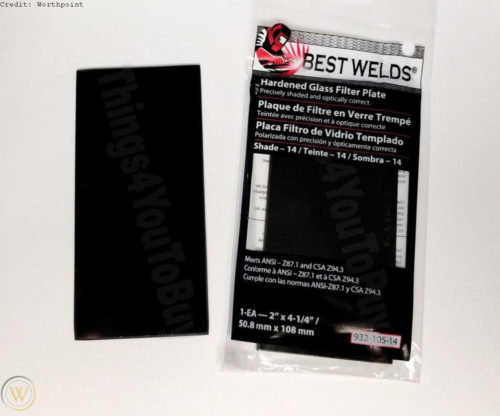
The progression will be the same as above, but you will also have to capture images that are exposed for your foreground as, during totality, all will be dark.
Again, research is the key here. No two scenes will be exactly alike as far as lighting, composition, and the position of the eclipse are concerned. Many photographers shoot with two cameras (or more) during an eclipse, to capture the celestial show from different perspectives and to improve their chances of getting a memorable image, or series of images.

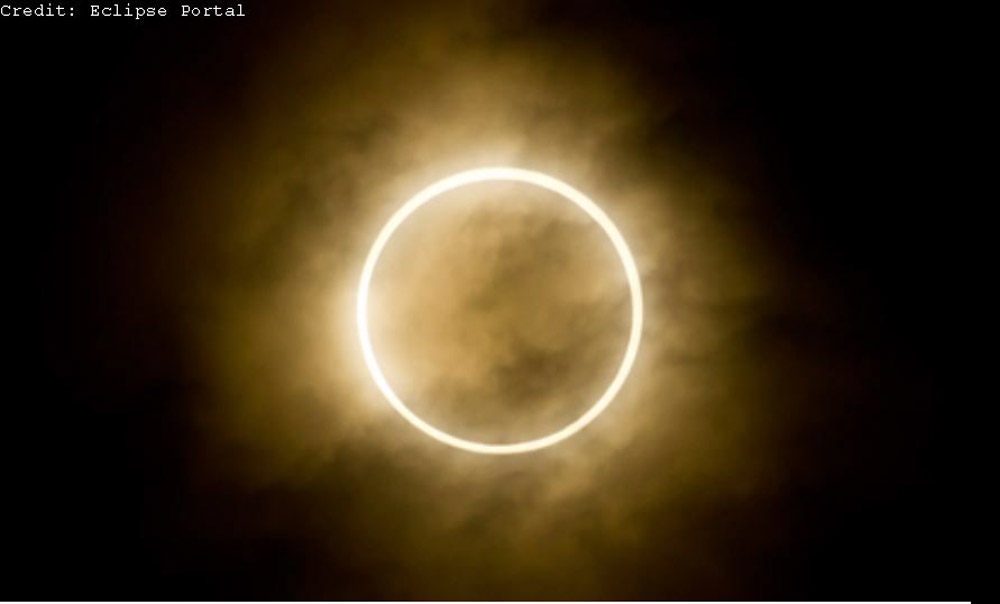
Very informative and will give a try.
Thanks for sharing the tips.
Very informative article Sir
Superb write-up. Very informative.
Informative thanks sir
The article about annular solar eclipse is informative. Being a professor in the department of mechanical engineering and an observational astronomer, I wish to strongly accentuate that, this type of eclipse happened on October 9, 1847 in southern India and is eventuating after 172 years with almost 95% obscurity. This is regarded as the rare astronomical spectacle. This form of eclipse will occur in 2064 again. So please do not forget to witness this pleasurable, extravagant, conspicuous, spectacular and overwhelming feast.
Thank you for technical informative support to all types of photographers
Thank you so much for the very explanatory article ! Helped a lot.
Very nice tutorial!
Thank you so much.
I’ll definetly give it a try.
Very informative article. It will help me to capture the Annular Solar Eclipse on 21 June 2020.
Thanks
That is super informative . Never seen a article so vast like this in this topics . Good job .
Thank you Prashanth 🙂